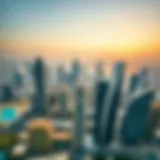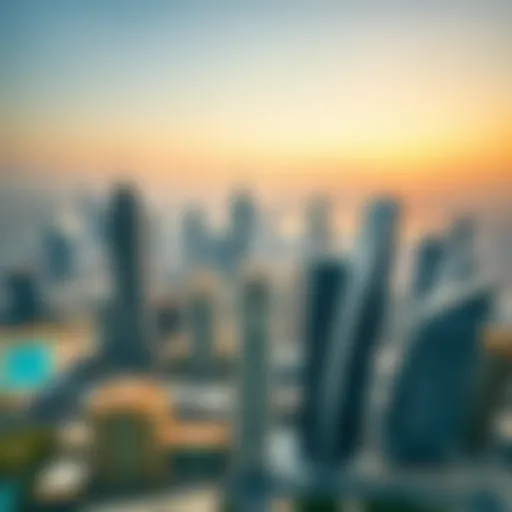Examining Dubai's Skyscraper-Driven Real Estate Market
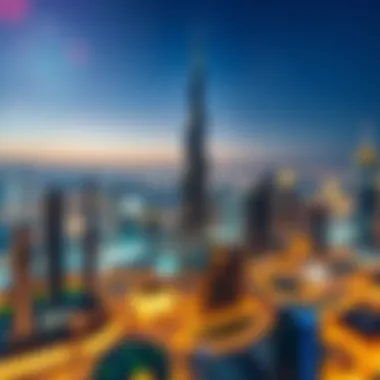

Intro
Dubai's skyline tells a story of ambition, innovation, and transition. At its heart are the towering skyscrapers, which do more than just touch the clouds; they embody the essence of a thriving real estate market that has captured global attention. Navigating this market requires understanding the undercurrents that drive it—factors like architectural significance, investment potential, and the socio-economic nuances of skyscraper living.
As the city expands upwards, the implications stretch far beyond aesthetics. This article aims to shed light on how these iconic structures influence the real estate landscape, creating opportunities for investors and shaping urban lifestyles. Expect to delve into current market trends, high-return investment zones, and emerging neighborhoods that are redefining Dubai.
The marriage of towering buildings and the real estate market in Dubai is not merely a phenomenon; it's a complex web of trends, demands, showcases of engineering prowess, and cultural shifts that impact residents and investors alike.
Market Trends
Current Market Analysis
The Dubai real estate scene has been riding a wave of transformation, especially in the context of its skyscrapers. In recent years, we've witnessed solid demand in prime areas, although some towers have garnered more attention than others due to their unique features and strategic locations.
It's important to note that rental yields in Dubai can be both a boon and a bane. High-profile towers like the Burj Khalifa and Marina 101 attract premium prices, but they also set the stage for competitive rental markets in surrounding locales. Investors looking for higher returns are paying attention to areas that blend accessibility and lifestyle offerings. Furthermore, these trends are extended by government initiatives to boost the economy, such as easing laws for foreign ownership and a push for sustainable urban developments that blend living with leisure.
Future Predictions
Looking ahead, the skyscraper landscape in Dubai is set for change, driven by evolving buyer preferences. As local culture embraces more sustainable forms of living, developers are increasingly investing in eco-friendly designs that promise long-term value.
Beyond aesthetics, smart technology integration within buildings offers prospective buyers enhanced living experiences. It’s predicted that areas like Dubai Creek Harbour will emerge as key hubs for the next wave of high-rise living, marrying luxury with sustainable practices. Presently, these shifts suggest that vertical living could see more engaged communities and increased investment opportunities as urban landscapes evolve in response to growing population and lifestyle needs.
"Dubai's skyline is not just a representation of its wealth—it's an architectonic manifesto that showcases the city's metamorphosis into an urban haven."
Investment Opportunities
High-Return Areas
Investors often seek areas with promising returns, and in Dubai, certain neighborhoods shine brighter. The following locations currently showcase trending opportunities:
- Downtown Dubai: The sheer allure of iconic landmarks like the Dubai Mall and Burj Khalifa draws both tourists and residents, creating a high demand for housing and rentals.
- Dubai Marina: Waterfront developments here attract affluent buyers and renters, bolstered by dining, shopping, and nightlife options.
- Business Bay: Emerging as a hub for businesses, the high-rise developments in this area appeal to professionals desiring convenient work-life balance.
These areas are typically characterized by high demand paired with the potential for rental yield increases, making them attractive for discerning investors.
Emerging Neighborhoods
Keep an eye out for neighborhoods that are on the rise and fast becoming desirable locations:
- Dubai South: This area is more than just an airport development; it’s part of a vision for a sustainable city with residential, commercial, and logistics sectors all integrated.
- Jumeirah Village Circle (JVC): It’s gaining traction due to its affordable living options and a neighborhood vibe that appeals to families and newcomers.
- Al Furjan: With extensive green spaces and newer residential units, it attracts young professionals and investors looking for value.
Exploring these neighborhoods offers not just insight into current investment climates, but also the emerging lifestyle choices of residents looking to make Dubai their home.
With the dynamics shifting rapidly, staying informed about the intricate connection between towering skyscrapers and the real estate market is crucial for investors, agents, and buyers alike. For further research, you might find insights at Dubai Land Department and curated discussions on platforms such as Reddit insightful.
Preface to Dubai's Architectural Landscape
Dubai stands as a testament to architectural ambition. The city’s skyline, dotted with historic and modern towers, is not just a visual feast but also a cornerstone of its real estate narrative. The introduction of architectural prowess in Dubai carries significant weight—it reflects the city’s socio-economic pulse and serves as a beacon for investment opportunities.
The towers in Dubai tell a story of progress and vision. From the earliest structures that laid the groundwork for vertical expansion to the most recent marvels pushing the boundaries of design, understanding this architectural landscape is pivotal for investors, agents, and buyers alike. These structures are often perceived as symbols of wealth and success, and knowing their history and characteristics invites a deeper engagement with the market.
Here are key elements worth noting:
- Diversification of Investments: Understanding how tower developments influence various sectors can lead to more informed investment decisions.
- Cultural Context: Towers often reflect the cultural shifts within the city, evolving as community living becomes more prevalent.
- Urban Dynamics: Analyzing the intricate relationship between architectural growth and urban development can enhance real estate strategies.
In unpacking the narrative of Dubai's architectural landscape, this section serves as a springboard into the specifics of tower development, providing insights that shape a comprehensive understanding of the city’s dynamic real estate environment.
Historical Context of Tower Development in Dubai

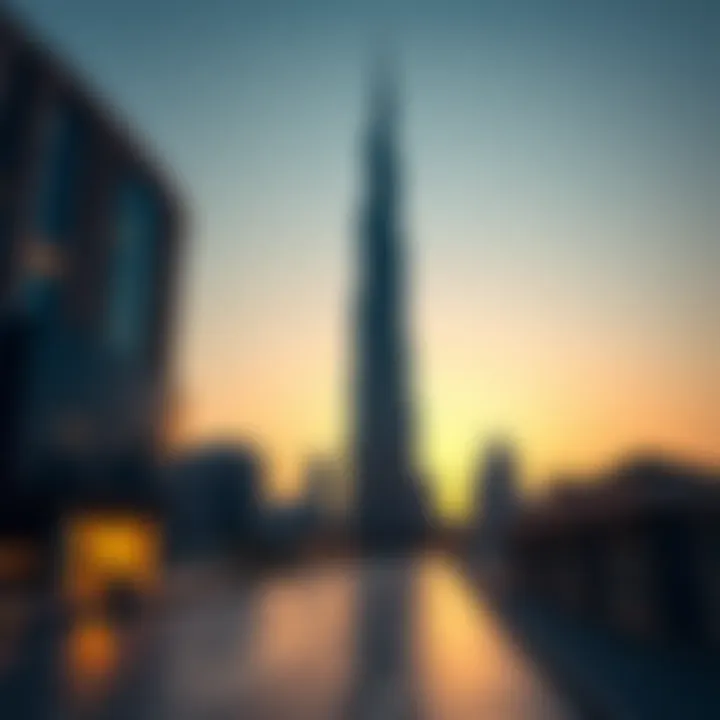
The emergence of skyscrapers in Dubai is a relatively recent affair, yet the impact has been profound. Before the 1970s, Dubai's skyline consisted mostly of modest buildings. The discovery of oil marked a turning point, catapulting the city into rapid development. Structures such as the Burj Al Arab, completed in 1999, symbolized not only luxury but also Dubai's desire to be recognized on a global scale.
Fast forward to the present, and the skyline has transformed into a playground for architects. Each tower represents a leap in engineering and design, often pushing the limits of what was thought possible. The historical context of these developments sheds light on their significance in attracting international investment and tourism, making it essential for stakeholders in real estate to comprehend their origins and evolution.
Defining Characteristics of Dubai's Towers
Dubai's towers aren't just tall—they are iconic, each with unique characteristics that set them apart from buildings elsewhere. For instance, take the Burj Khalifa, the tallest building in the world, which soars to a staggering height of 828 meters. Its sleek design and innovative technology are a testament to Dubai's commitment to cutting-edge architecture.
Consider also the Burj Al Arab, designed to resemble a sail, standing proudly on its own island. This vertical construct is not only a landmark but also a symbol of luxury and opulence.
Some defining traits of Dubai’s towers include:
- Innovative Design: Many towers feature unique architectural elements that blend form with function, drawing visitors and residents alike.
- Sustainability: Newer buildings incorporate eco-friendly technologies and materials, addressing global concerns about climate change.
- Cultural Representation: Towers reflect the rich tapestry of Dubai’s identity, often borrowing elements from local culture to create structures that resonate on a personal level.
Understanding these characteristics offers a glimpse into why these buildings are not merely places to live or work; they are cultural landmarks that embody the spirit of innovation and growth prevalent in Dubai’s skyline.
Iconic Towers in Dubai
The skyline of Dubai is adorned with an array of iconic towers, each serving as a testament to the architectural prowess and ambition of the city. These towers do more than just scrape the sky; they encapsulate the spirit of Dubai's rapid growth and its status as a global hub for business and tourism. Their uniqueness lies not only in their design but also in the lifestyle they offer and their contributions to the real estate market.
When considering investments, the presence of these buildings often influences market dynamics, making them critical for potential buyers and investors. Iconic towers often drive property values up, acting as landmarks that enhance the desirability of surrounding areas. This guide delves into three of the most celebrated structures in Dubai, exploring their architectural significance, luxurious offerings, and their role in shaping the socio-economic landscape of the market.
Burj Khalifa: A Pinnacle of Innovation
Burj Khalifa stands tall as the tallest building in the world, reaching a staggering height of 828 meters. This architectural marvel is more than a feat of engineering; it is a statement of what Dubai represents—innovation and grandeur. Completed in 2010, Burj Khalifa combines advanced technology, sleek design, and stunning views that attract millions of visitors annually.
For investors, Burj Khalifa represents both an opportunity and a challenge. Properties within this vicinity often command high rental yields and resell at premium prices due to the building's iconic status. The luxurious amenities such as high-end restaurants and observation decks only add to its appeal, marking it as a top contender in property investments.
Moreover, the Burj Khalifa influences the market by serving as a benchmark for luxury developments across the emirate. Buyers looking at properties nearby often factor in the prestige that comes with living close to such a notable landmark.
Burj Al Arab: Symbol of Luxury
Burj Al Arab is synonymous with opulence, often hailed as one of the most luxurious hotels in the world. Shaped like a sail, this hotel not only provides lavish accommodations but also offers a glimpse into Dubai’s luxurious lifestyle. It has redefined hospitality, with its exclusive services such as private butlers and helipad facilities.
The tower not only draws tourists; it's also critical for high-net-worth buyers interested in luxury real estate. Properties in the vicinity are more than just homes; they are investments in a lifestyle of grandeur. The Burj Al Arab doesn’t merely enhance real estate appeal, it creates a demand for luxury living that far exceeds standard market trends.
This iconic structure also fosters a community vibe, attracting residents who appreciate more than just luxury; they seek a quality of life enriched by design and exclusivity. As a result, Burj Al Arab has become a beacon for high-end developments, noticeably shaping the luxury real estate market in Dubai.
The Address Downtown: A Hub of Activity
The Address Downtown is more than a luxury hotel; it plays a vital role in the urban fabric of Dubai. Located near the Burj Khalifa and Dubai Mall, it caters to a diverse clientele, from tourists to business travelers. Its strategic location and extensive facilities make it a bustling hub filled with cafes, shops, and entertainment options.
Investors see The Address Downtown as an attractive portfolio addition due to its reputation and footfall. Properties in the surrounding area benefit from a steady influx of visitors, ensuring that rental yields remain consistently high. The locality’s mix of commercial and residential spaces provide a well-rounded investment opportunity.
The tower echoes a balance of lifestyle and convenience, tapping into the essence of urban living in Dubai. It symbolizes how towers can create vibrant communities, seamlessly blending luxury with livability.
"The iconic structures in Dubai are not just towers; they are symbols of ambition, innovation, and the ever-evolving landscape of real estate."
In summary, the iconic towers of Dubai represent more than architectural triumphs. They serve pivotal roles in the real estate market, creating opportunities while shaping lifestyles across the city. As urban dynamics continue to evolve, these towers will remain at the heart of Dubai's majestic skyline.
Real Estate Trends Influenced by Towers
The feet of monumental towers in Dubai tell tales of ambition and growth, encapsulating the essence of the city’s real estate dynamics. As the skyline continually evolves, an intricate relationship between skyscrapers and property trends has taken form, impacting the way both investors and residents view urban living. Each towering edifice does more than just reach for the sky; it serves as a barometer for market trends, offerings, and investment opportunities.
Why should one pay heed to real estate trends influenced by these towers? Understanding how they affect both residential and commercial sectors provides insight into the future of Dubai’s real estate landscape. The landscape is shaped not only by architectural grandeur but also by shifts in demographics, lifestyle preferences, and economic factors. This understanding becomes essential for anyone looking to navigate the complexities of the market effectively.
Moreover, the impact of vertical living translates into concepts like efficient land use and the burgeoning demand for high-rise residential units versus commercial spaces. This leads us to explore two critical dimensions shaping the tower landscape in Dubai:
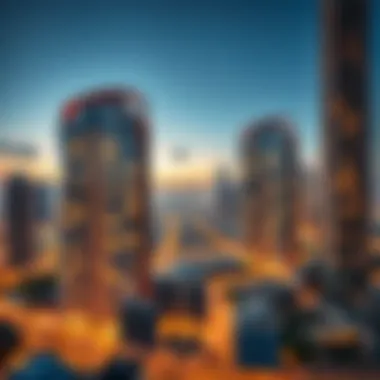
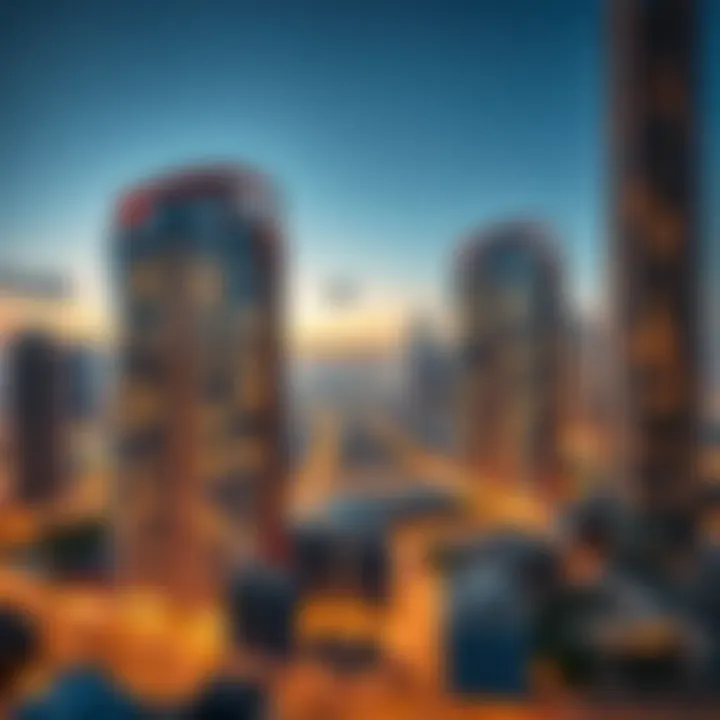
- Skyward Growth: The Rise of Vertical Living
- Demand Dynamics: Residential vs. Commercial Towers
Skyward Growth: The Rise of Vertical Living
As the world wrestles with the challenges of urbanization, Dubai has become a canvas where vertical living is painted in bold strokes. Gone are the days of sprawling suburban developments as more residents opt for the convenience of living in high-rise towers. Skyward growth is not just a trend; it has become a necessity driven by a soaring population and limited land availability.
The concept of vertical living comes with numerous advantages that cater to the needs of the modern urban dweller. For one, having essential amenities close at hand fosters a sense of community in what could otherwise be an overwhelming city. Tailored spaces within towers often include grocery stores, gyms, and cafes, which makes day-to-day living seamless.
Investment in vertical living has also attracted international buyers, who are drawn to the benefits of prime location and unique design features. Moreover, these skyscrapers are increasingly designed with sustainability in mind, showcasing features like solar panels and green roofs—elements that resonate well with environmentally conscious investors.
Perception Shift
A shift in perception has emerged where high-rise buildings are equated with a prestigious lifestyle. With luxury apartments at the top of towers—like the ones in The Address Downtown—people see them not just as homes but as investments in their social status.
Demand Dynamics: Residential vs. Commercial Towers
As trends evolve, it’s crucial to dissect the differences in demand between residential and commercial towers. Both sectors are influenced by distinct factors that define their market strategies.
Residential Towers
Residential towers in Dubai have seen increasing interest due to lifestyle preferences shifting towards urban living. Families, young professionals, and expatriates prefer the convenience of access to schools, work, and entertainment options all bundled in one location. As a result, properties like the Burj Khalifa have translated into lucrative rental markets due to their prestige and location.
Key factors driving demand for residential spaces:
- Lifestyle Needs: Proximity to work and leisure activities.
- Amenities and Facilities: Modern conveniences right at their doorstep.
- Community Living: A sense of belonging that fosters social interaction.
Commercial Towers
On the flip side, commercial properties, especially those designed as office spaces or mixed-use towers, are adapting to new market conditions. The COVID-19 pandemic has spurred a reevaluation of workplace designs as remote work becomes more normalized. Yet, there remains a demand for high-tech office spaces equipped with flexible layouts. Investors now eye buildings that provide shared spaces, lounges, and environmentally friendly features, responding to a changing work environment.
Key factors influencing commercial tower demand:
- Flexible Workspaces: Adaptability to cater to hybrid working models.
- Location Accessibility: Strategic positioning in business districts.
- Technological Integration: Smart buildings that improve efficiency and comfort.
In short, the landscape of Dubai’s real estate market is swayed by the towering giants that define its skyline. As one navigates through the intricate tapestry of residential and commercial towers, understanding these trends becomes crucial for making informed investment decisions. The rise of vertical living is not merely a momentary blip; it’s the way of the future.
Investment Opportunities in Tower Properties
The fascinating growth of tower properties in Dubai's real estate market opens doors to numerous investment opportunities. With unique architectural designs and strategic locations, these towers are more than just eye candy; they represent significant financial potential. Investors, both local and global, are increasingly drawn to the Dubai real estate market due to its vibrant economy and favorable investment climate. Understanding the dynamics of tower investments is crucial for making informed decisions.
Assessing Value: Evaluating Tower Investments
Evaluating the value of tower investments involves a blend of financial acumen and market analysis. It’s not just about the price per square meter; factors like location, amenities, and the history of the developer play pivotal roles. Potential investors must assess:
- Location: Is the tower in a hot spot for tourism or business? Properties near prominent landmarks or in areas with good transport links generally appreciate faster.
- Amenities: High-end towers offer resort-style amenities, which are appealing to buyers. Pools, gyms, and lounges enhance desirability, thus elevating property value.
- Developer Reputation: Reliable developers with a proven track record inspire confidence. Their previous projects' performance is a good indicator of future success.
Understanding these elements can shed light on the potential return on investment. For example, a tower in the bustling Dubai Marina might demand a premium due to its scenic views and vibrant community. When making decisions, consider consulting real estate analysts who can provide valuable insights and localized market reports.
"In real estate, it’s not about timing the market; it’s about time in the market."
Emerging Markets: Upcoming Towers to Watch
New projects are constantly in the pipeline, each promising a fresh perspective on urban living. Recognizing upcoming towers can place savvy investors at an advantage, allowing them to enter potentially lucrative markets early. Some noteworthy upcoming towers which deserve attention include:
- Dubai Creek Tower: Set to rise even taller than the Burj Khalifa, this tower aims to redefine the skyline yet again. It’s positioned to be a focal point in the city’s future urban landscape.
- Vista Tower at Dubai Hills: This project is attracting attention for its eco-friendly design and family-oriented amenities. With a strategic location, it promises to blend luxury living with practicality.
- Safa Two: This innovative twin tower is designed to be a marvel of modern architecture. Its unique features and adaptable living spaces cater to a diverse set of buyers and investors.
Investors should also keep an eye on regional urban developments beyond the main core of the city. Areas like Jumeirah Village Circle are showing potential due to improved infrastructure and a growing expatriate community. They can provide a more affordable entry point while still offering promising returns in the long term.


As the Dubai real estate market evolves, keeping an ear to the ground for emerging projects and forecast trends creates an advantageous position for investment.
Socio-Economic Impact of Towers in Dubai
The towering skyline of Dubai is not merely an aesthetic wonder; it embodies a complex interplay between architecture and socio-economic growth. As skyscrapers rise, they transform the urban landscape, influencing local economies, social dynamics, and cultural practices. The socio-economic impact of towers in Dubai transcends the physical structures, weaving into the fabric of the community and enhancing the quality of urban living. This section explores the unique benefits and challenges associated with vertical development in this bustling city.
Cultural Shifts: Community Living in Tall Structures
Living high up in the clouds introduces a new paradigm. Many residents find a sense of community despite the height. These tower complexes are designed with social spaces where people can meet and mingle. Think about it—when a person shares an elevator with their neighbor, it can spark a conversation that leads to stronger ties within the community.
- Diversity of Residents: Many towers attract a mix of people from various backgrounds, fostering cultural exchange. You'll catch glimpses of different traditions and lifestyles, right from your balcony.
- Shared Amenities: Facilities like gyms, pools, and gardens encourage interactions among residents. It’s almost a microcosm of city life—offering a shared experience without the need to venture out.
- Urban Connectivity: High-rise living demands infrastructure that supports easier connections to the rest of the city. This improvement in connectivity can boost social engagement and lessen the feel of isolation, which can sometimes plague urban settings.
In this evolving environment, residents are choosing a lifestyle that prioritizes convenience and community. The notion of extending one’s social circles beyond the ordinary neighborhood resides right within the tall towers.
Environmental Considerations: Sustainable Tower Design
Sustainability is a hot topic in real estate conversations today. As more skyscrapers dot the Dubai horizon, the way they integrate with the environment becomes pivotal. Sustainable tower design isn't merely about efficiency; it's a philosophy that pushes architects and developers to innovate and produce structures that respect and enhance their surroundings.
- Energy Efficiency: Modern towers prioritize energy-efficient systems. Features like solar panels and smart climate control not only lower operational costs but also lessen the carbon footprint.
- Water Conservation: Use of recycled water for landscaping and plumbing is becoming commonplace. Towers that integrate these systems can significantly impact overall water usage, especially in a desert environment.
- Green Roofs and Vertical Gardens: By incorporating greenery, towers can reduce urban heat and improve air quality. The sight of plants climbing upwards not only beautifies but also serves a functional purpose, helping to promote biodiversity in the concrete jungle.
Adopting sustainable practices contributes not just to environmental protection but also enhances the desirability of tower living. Investors are increasingly aware that properties which embrace sustainability can yield better long-term returns.
"The responsible design of towers not only shapes skylines but also holds the key to sustainable urban futures."
Ultimately, the socio-economic impact of Dubai’s towers extends in myriad directions – enriching community life and paving the way for sustainable urban development. As this dynamic landscape continues to evolve, it paints a vivid picture of the interplay between living, working, and playing within these soaring giants.
Navigating the Tower Market: Buyer Insights
The real estate market in Dubai, particularly in relation to its towering developments, requires a discerning eye. Potential buyers face a myriad of options, each with its distinct advantages and pitfalls. Understanding how to navigate this complex terrain is invaluable for anyone looking to invest wisely. Towers in Dubai encompass both luxurious living spaces and commercial hubs, making the stakes quite high when it comes to investment. Knowing what to look for is paramount in seizing opportunities that lie within this dynamic sector.
Choosing the Right Tower: Factors for Buyers
When it comes to selecting a tower in Dubai, buyers should consider a variety of factors that can influence their investment. Some key elements include:
- Location: A tower’s position within the city can significantly affect its value. Areas near business districts or key attractions often yield higher returns.
- Amenities: Towers that offer a range of amenities, such as pools, gyms, and community areas, tend to attract buyers more readily.
- Reputation of Developer: Researching the credibility of the developer is crucial. Established names often provide better assurance of quality and timely completion.
- Market Trends: Buyers should stay informed about the prevailing market conditions. For instance, some towers may be in high demand, while others may offer better value at a lower price.
- Future Developments: It’s important to consider planned or potential future developments in the vicinity, as these can enhance property values.
Being cognizant of these factors can help buyers make informed decisions, leading to more fruitful investments.
Market Predictions: Future of Tower Developments
Looking ahead, the future of tower developments in Dubai appears promising, albeit with certain shifts on the horizon. Industry experts predict a growing trend towards sustainability and smart technology integration in future skyscrapers. Here are some anticipated changes:
- Sustainable Designs: There’s an increasing emphasis on environmentally friendly constructions. Towers that adhere to green building standards may attest to more significant long-term value.
- Integration of Smart Technologies: Features such as smart home technology and energy-efficient systems are likely to become standard in new towers, aligning with global trends.
- Focus on Community-oriented Spaces: Developers may pivot towards creating more community-focused towers that foster social interaction, rather than just providing living or working spaces.
"With every new tower, Dubai sets a benchmark that transcends the ordinary. Keeping a finger on the pulse is vital for any investor."
As the city evolves, so too do the opportunities for those willing to adapt and engage with the real estate market thoughtfully. For anyone considering an investment in this region, keeping abreast of these trends can provide a competitive edge.
Ending: Towers as a Reflection of Dubai's Growth
Dubai’s skyline, a tapestry of soaring structures, serves not merely as a visual feast, but as a lens through which the city’s rapid economic and cultural evolution can be observed. The towers, towering above the ordinary, encapsulate the ambitions of a city striving for greatness. They symbolize the synergy of art and architecture, commercial foresight and residential comfort.
The significance of these towers can be distilled into several key elements:
- Economic Catalysts: These skyscrapers are integral to Dubai's real estate market, acting as catalysts for investment and development. Their construction fuels job creation and stimulates the economy. This impact extends beyond real estate, shaping industries such as tourism, retail, and hospitality.
- Cultural Landmarks: As part of the cultural identity, each tower tells a story reflecting Dubai’s journey from a humble fishing village to a global city. The Burj Khalifa, for example, isn’t just a skyscraper; it's an icon representing resilience, innovation and luxury.
- Environmental Challenges and Responses: Despite the allure of towers, they also pose significant environmental considerations. As these vertical spaces continue to grow, so does the need for sustainable practices in their design and construction. Developers are increasingly adopting green technologies and materials to lessen their impact on the environment—all part of the equation as Dubai continues to thrive.
- Social Dynamics: The rise of vertical living has shifted social paradigms, pushing community interactions into shared spaces within these towers. While some residents relish in the conveniences and connections, others may feel the loss of traditional community structures. Understanding these dynamics is crucial for future developments in the city.
"In a city defined by its ambition, the towers stand as testaments not only to architectural prowess but to a vision that continuously seeks greater heights."
The Future of Vertical Living in Dubai
The outlook for vertical living in Dubai remains optimistic. As the city pursues ambitious urban planning initiatives, the potential for new towers continues to rise. Here are several notable trends shaping this future:
- Technological Integration: The future of these towers will likely marry architecture with advanced technology. Smart buildings equipped with artificial intelligence for energy efficiency and security are on the horizon, enhancing the living experience.
- Cultural Fusion: As Dubai continues to cultivate a multicultural environment, new designs will reflect diverse architectural influences, promoting a blend of cultural aesthetics. Towers could emerge as symbols of unity in diversity, shaping cultural identity while providing a modernized living space.
- Enhanced Community Spaces: Future developments might focus more on communal spaces within skyscrapers, such as parks, gardens, and gathering areas to foster community interaction and preserve a sense of belonging in these vertical habitats.
- Sustainability: People are more conscious than ever about environmental impacts. Future towers may employ sustainable practices such as vertical gardens, energy-efficient systems, and eco-friendly materials that enhance their appeal while ensuring a commitment to eco-conscious living.
As we look ahead, it’s evident that the towering structures of Dubai are not just physical entities but vital components that reflect the pulse of a city in constant motion. Understanding their role allows us to appreciate their significance and implications on the future of urban living.






